Scientists have uncovered two miniature spiders living on mountains in China’s southern region, one of which is among the smallest spiders recorded worldwide, according to a new paper in ZooKeys. Both spiders belong to the Mysmenidae family, which is made up of mini-spiders with eight eyes.
“Although the family Mysmenidae is distributed worldwide, it is one of the least-studied family-level groups among orb-weaving spiders, and its diversity is grossly undersampled due to their small size (0.7–3 mm) and cryptic life style,” the scientists write. Currently found on every continent but Antarctica, it’s likely many more Mysmenidae remain undiscovered.
Measuring just over a millimeter, Trogloneta yuensis was discovered on Jinyun Mountain in Chongqing. It is covered in dark, irregular spots, almost leopard-like. Meanwhile, the other new species, Mysmena wawuensis is considerably smaller at only 0.75 millimeter, making it among the tiniest arachnids. Mysmena wawuensis was named after the mountain it inhabits: Wawu Mountain, which is also home to a small population of giant pandas. Both spiders are believed to wholly confined to the mountains where they were discovered.
Spiders in the Mysmenidae family, which currently number around 120, are usually found in humid habitats hiding out in leaf litters or moss. A few have been discovered in caves.

A male of the new species: Mysmena wawuensis. Photo by: Lin et al.

A female of the new species: Mysmena wawuensis. Photo by: Lin et al.
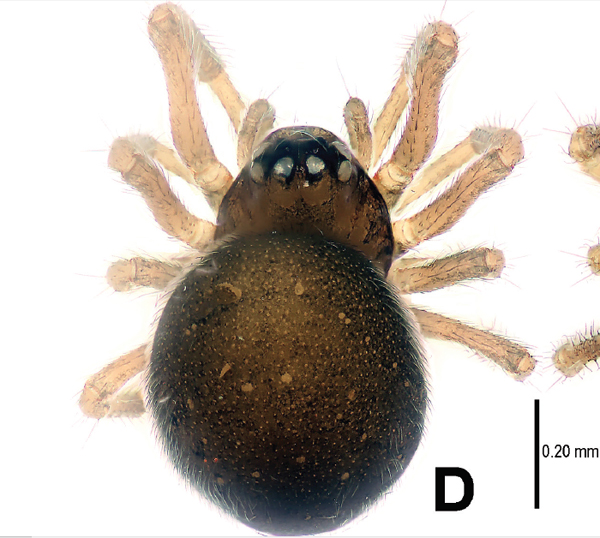
Another view of the female Mysmena wawuensis. Photo by: Lin et al.
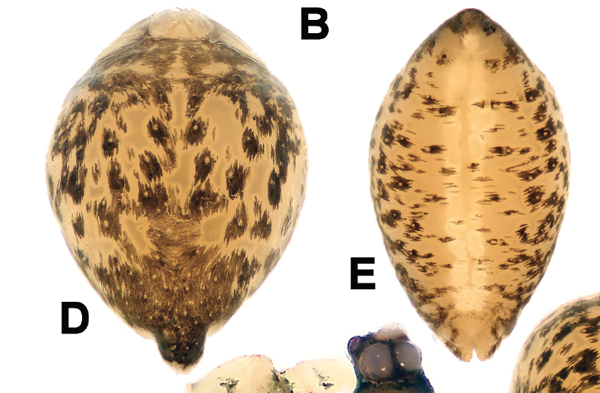
Spotted body of Trogloneta yuensis. Photo by: Lin et al.
CITATION: Lin Y, Li S (2013) Two new species of the genera Mysmena and Trogloneta (Mysmenidae, Araneae) from Southwestern China. ZooKeys 303: 33–51. doi: 10.3897/zookeys.303.4808.
Related articles
Three new species of carnivorous snails discovered in endangered habitat in Thailand (photos)
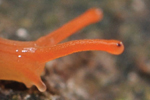
(05/23/2013) Scientists from Chulalongkorn University, Bangkok and the Natural History Museum, London recently discovered three new species of carnivorous snails in northern Thailand. However, the celebration of these discoveries is tainted by the fact that the new snails are already threatened with extinction due to the destruction of their limestone habitat.
Pictures: Top 10 new species of 2012
(05/23/2013) A glow-in-the-dark cockroach, an insect described from a photo posted on Flickr, a monkey that has been likened to Jesus, a carnivorous sea sponge, and the world’s tiniest frog are among the ‘top 10’ species discovered during 2012, according to global committee of taxonomists.
New prehistoric animal named after Johnny Depp due to its ‘scissorhands’
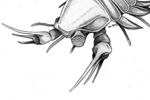
(05/19/2013) Half a billion years after an arthropod with long triple claws roamed the shallow Cambrian seas, scientists have named it after Hollywood movie actor, Johnny Depp: Kooteninchela deppi. Depp, known for his versatility as an actor, played Edward Scissorhands—an artificial man with long scissors for hands—in a popular 1990 film.
Scientists discover new giant mole rat in Africa (photos)
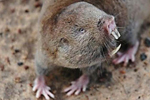
(04/30/2013) Although the term “giant mole rat” may not immediately inspire love, the mole rats of Africa are a fascinating bunch. They spend practically their entire lives underground building elaborate tunnel systems and feeding on plant stems. This underground lifestyle has led them to evolve small ears, tiny eyes, forward-pointing teeth for digging, and nostrils they can shut at will while digging. Some species are quite social, such as the most famous, the naked mole rat (Heterocephalus glaber), while others live largely solitary lives. If that’s not enough, the family of mole rats, dubbed Blesmols, may even help us find a cure for cancer.

(04/22/2013) The misty mountains of the Western Ghats seem to unravel new secrets the more you explore it. Researchers have discovered two new frog genera, possibly restricted to rare and threatened freshwater swamps in the southern Western Ghats of India. The discoveries, described in the open-access journal Zootaxa, prove once again the importance of the mountain range as a biodiversity hotspot.
New insect discovered in Brazil, only third known in its bizarre family (photos)

(04/15/2013) A new species of forcepfly named Austromerope brasiliensis, was recently discovered in Brazil and described in the open access journal Zoo Keys. This is the first discovery of forcepfly in the Neotropics and only the third known worldwide. The forcepfly, often called the earwigfly because the male genital forceps closely resemble the cerci of the common earwig, remains a scientific enigma due to the lack of information on the family.
New species tree-dwelling porcupine discovered in critically threatened Brazilian habitat
(04/11/2013) Scientists in Brazil have described a new species of tree-dwelling porcupine in the country’s most endangered ecosystems. The description is published in last week’s issue of Zootaxa.
Beautiful striped bat is the “find of a lifetime” (photos)

(04/10/2013) Scientists have uncovered a rare, brilliantly-striped bat in South Sudan that has yielded new secrets after close study. Working in Bangangai Game Reserve during July of last year, biologist DeeAnn Redeer and conservationist Adrian Garsdie with Fauna & Flora International (FFI) came across an unmissable bat, which has been dubbed by various media outlets as the “badger bat” and the “panda bat.”
Looking beyond the hundred legs: finding new centipedes in India requires many tools
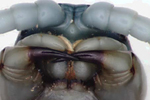
(04/08/2013) A small, boneless creature, that lives underground, with a “hundred” legs, and a rather powerful sting; some of these creatures are drab, but some are so beautiful and brightly colored that they can startle. Centipedes. There is more to a centipede than its many legs, and its habit of darting out of dark places. One of the first lifeforms to turn up on land, some centipede fossils date back to about 450 million years ago. They have been evolving steadily since, with some estimates showing about 8,000 species today. Not even half of these species have been taxonomically described.